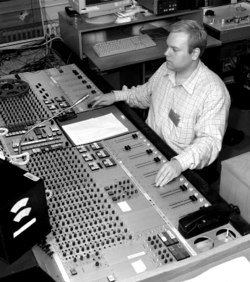- Record producer
-
Record producer 
A Danish recording sessionOccupation Names Record Producer
Recording ArtistActivity sectors Music Industry
MusicDescription Competencies Instrumental Skills, Keyboard Knowledge A record producer is an individual working within the music industry, whose job is to oversee and manage the recording (i.e. "production") of an artist's music. A producer has many roles that may include, but are not limited to, gathering ideas for the project, selecting songs and/or musicians, coaching the artist and musicians in the studio, controlling the recording sessions, and supervising the entire process through mixing and mastering. Producers also often take on a wider entrepreneurial role, with responsibility for the budget, schedules, and negotiations.
Today, the recording industry has two kinds of producers: executive producer and music producer; they have different roles. While an executive producer oversees a project's finances, a music producer oversees the creation of the music.
A music producer can, in some cases, be compared to a film director, with noted practitioner Phil Ek himself describing his role as "the person who creatively guides or directs the process of making a record, like a director would a movie. The engineer would be more the cameraman of the movie."[1] The music producer's job is to create, shape, and mold a piece of music. The scope of responsibility may be one or two songs or an artist's entire album – in which case the producer will typically develop an overall vision for the album and how the various songs may interrelate.
In the US, before the rise of the record producer, someone from A&R would oversee the recording session(s), assuming responsibility for creative decisions relating to the recording.
With today's relatively easy access to technology, an alternative to the record producer just mentioned, is the so called 'bedroom producer'. With today's technological advances, it is very easy for a producer to achieve high quality tracks without the use of a single instrument. Many established artists take this approach.
In most cases the music producer is also a competent arranger, composer or songwriter who can bring fresh ideas to a project. As well as making any songwriting and arrangement adjustments, the producer is also in charge of the creative mix. He or she will liase with the sound engineer who concentrates on the technical aspects of recording, whereas the music producer keeps an eye on the overall projects marketability.
Contents
History
Early record producers
During the 1890s, Fred Gaisberg ran the first recording studio and provided the closest approximation of production by guiding an opera singer closer or further away from a gramophone's horn to match the dynamics in the score. (Citation: Gronow and Saunio 1998, p. 8; Moorefield 2005, p. 1).
However in the first part of the 20th century the record producer's role was similar to the role of a film producer in that the record producer organized and supervised recording sessions, paid technicians, musicians and arrangers, and sometimes chose material for the artist. In the mid-1950s a new category emerged, that of the independent record producer. Among the most famous early independent producers are the famed songwriting-production duo Leiber & Stoller, "Wall of Sound" creator Phil Spector and British studio pioneer Joe Meek.
Magnetic tape enabled the establishment of independent recording studios in major recording centres such as London, Los Angeles and New York. Unlike the old record company studios, which were effectively a "closed shop", these new studios could be hired by the hour by anyone who could afford to do so.
The biggest and best commercial studios were typically established and operated by leading recording engineers. They were carefully constructed to create optimum recording conditions, and were equipped with the latest and best recording equipment and top-quality microphones, as well as electronic amplification gear and musical instruments.
Top-line studios such as Olympic Studios in London, Fine Recording in New York City, United Western Recorders, and Musart in Los Angeles quickly became among the most sought-after recording facilities in the world, and both these studios became veritable "hit factories" that produced many of the most successful pop recordings of the latter 20th century.
Evolution of the role of the producer
Prior to the 1950s, the various stages of the recording and marketing process had been carried out by different professionals within the industry – A&R managers found potential new artists and signed them to their labels; professional songwriters created new material; publishing agents sold these songs to the A&R people; staff engineers carried out the task of making the recordings in company-owned studios.
Freed from this traditional system by the advent of independent commercial studios, the new generation of entrepreneurial producers – many of whom were former record company employees themselves – were able to create and occupy a new stratum in the industry, taking on a more direct and complex role in the musical process. This development in music was mirrored in the TV industry by the concurrent development of videotape recording and the consequent emergence of independent TV production companies like Desilu.
These producers now typically carried out most or all of these various tasks themselves, including selecting and arranging songs, overseeing sessions (and often engineering the recordings) and even writing the material[2] . Independent music production companies rapidly gained a significant foothold in popular music and soon became the main intermediary between artist and record label, signing new artists to production contracts, producing the recordings and then licensing the finished product to record labels for pressing, promotion and sale. (This was a novel innovation in the popular music field, although a broadly similar system had long been in place in many countries for the production of content for broadcast radio.) The classic example of this transition is renowned British producer George Martin, who worked as a staff producer and A&R manager at EMI for many years, before branching out on his own and becoming a highly successful independent producer.
As a result of these changes, record producers began to exert a strong influence, not only on individual careers, but on the course of popular music. A key example of this is Phil Spector, who defined the gap between early rock and roll and the Beatles (1959–1964) with such acts as the Ronettes, the Crystals, Darlene Love, the Righteous Brothers and the Paris Sisters. Spector's Wall of Sound production technique also persisted after that time with his select recordings of the Beatles, the Ramones, Leonard Cohen, George Harrison, Dion and Ike and Tina Turner.
Some producers also became ipso facto recording artists, often creating records themselves or with anonymous studio musicians and releasing them under a pseudonym. Examples of this phenomenon include the records by fictional groups the Archies and Josie & the Pussycats, produced by Don Kirshner and Danny Jansen respectively, who were contracted by TV production companies to produce these records to promote the animated children's TV series of the same name. Similarly, Jeff Barry and Andy Kim recorded as the Archies. The same producer-as-artist phenomenon can be found with many modern-day pop-oriented street- and electronic-music artists.
Another change that occurred for the role of producers occurred progressively over the 50’s and 60’s. Popularization of new technology such as synthesizers, electric guitars, amplifiers, and better microphones led to a fundamental switch. The goal of recording no longer was simply accurately capturing and documenting live performance. Instead producers could manipulate sounds. Producers became creative figures in the studio were no longer reserved to role of functional engineer. Examples of such engineers includes George Martin, Joe Meek, Teo Macero, Phil Spector, Brian Wilson, and Biddu. These producers became known as creative producers who turned the studio into a creative space.
Equipment and technology
There are numerous different technologies utilized by the producer. In modern day recordings, recording and mixing tasks are centralized within computers. However, there is also the main mixer, outboard effects gear, and the recording device itself.
See also
References
- ^ "Interview with Phil Ek". HitQuarters. 25 May 2009. http://www.hitquarters.com/index.php3?page=intrview/opar/intrview_Phil_Ek_Interview.html. Retrieved Sep 3, 2010.
- ^ Dan, Connor. "The Role of a Music Producer". The Stereo Bus. http://thestereobus.com/2007/12/07/the-role-of-a-music-producer-explained/. Retrieved 4 September 2011.
Further reading
- Gibson, David and Maestro Curtis. "The Art of Producing". 1st. Ed. USA. ArtistPro Publishing, 2004. ISBN 1931140448
- Burgess, Richard James. The Art of Music Production. 3rd Ed. UK. Music Sales, 2005. ISBN 1-84449-432-4
- Hewitt, Michael. Music Theory for Computer Musicians. 1st Ed. USA. Cengage Learning, 2008. ISBN 13-978-1-59863-503-4
- Gronow, Pekka and Ilpo Saunio (1998). An International History of the Recording Industry. ISBN-X. Cited in Moorefield (2005).
- Moorefield, Virgil (2005). The Producer as Composer: Shaping the Sounds of Popular Music. ISBN. 123
- Olsen, Eric et al. (1999). The Encyclopedia of Record Producers. ISBN 0823076075 9780823076079
- Zak, Albin. The Poetics of Rock: Cutting Tracks, Making Records. Berkeley: University of California Press, 2001.
- List of the Producers of the Current Top 100 Songs, Top 100 – Album Credits
External links
Music History of music Prehistoric · Ancient · Biblical · Medieval · Renaissance · Baroque · Classical period · Romantic · 20th century · Contemporary · 21st century
Composition Education and careers Production Cultural and regional genres of music African (Central African · East African · North African · Southern African · West African) · Asian (Central Asian · East Asian · Middle Eastern · South Asian · Southeast Asian) · European (Central European · Eastern European · Northern European · Southeastern European · Southern European · Western European) · Latin American (Central American · South American) · North American (Canadian · Caribbean · United States) · Oceanian (Australian · Melanesian · Micronesian · New Zealand · Polynesian)Lists Index · Glossary of jazz and popular musical terms · Glossary of musical terminology · Outline · Musical forms by era · Instruments · AudioRelated topics Category · Portal · WikiProject Categories:- Record producers
- Music production
Wikimedia Foundation. 2010.

